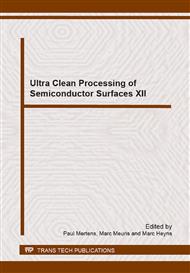[1]
M.E. Abdelsalam, P.N. Bartlett, T. Kelf, and J. Baumberg: Langmuir 21 (2005), p.1753.
Google Scholar
[2]
P.M. Harder, T.A. Schedd, and M. Colburn: J. Adhesion Sci. Tchnol. 22 (2008), p. (1931).
Google Scholar
[3]
X. Xu, G. Vereecke, C. Chen, G. Pourtois, S. Armini, N. Verellen, W. -K. Tsai, D. -W. Kim, E. Lee, C. -Y. Lin, P. Van Dorpe, H. Struyf, F. Holsteyns, V. Moshchalkov, J. Indekeu, S. De Gendt: ACS Nano 8(1) (2014), p.885.
DOI: 10.1021/nn405621w
Google Scholar
[4]
G. Vereecke, XiuMei Xu, W.K. Tsai, Hui Yang, S. Armini, T. Delande, G. Doumen, F. Kentie, Xiaoping Shi, I. Simms, K. Nafus, F. Holsteyns, H. Struyf, and S. De Gendt: ECS J. Solid State Sci. Technol. 3(1) (2014), p. N3095.
DOI: 10.1149/2.013401jss
Google Scholar
[5]
I. Vos, D. Hellin, J. Vertommen, M. Demand and W. Boullart, ECS Trans. 41(5) (2011), p.189.
Google Scholar
[6]
X. Shi, R. Kurstjens, I. Vos, J. -L. Everaert and M. Schaekers, ECS Trans. 34 (1) (2011), p.535.
DOI: 10.1149/1.3567632
Google Scholar
[7]
M. Knotter, in: Handbook of Cleaning for Semiconductor Manufacturing (K.A. Reinhardt and R.F. Reidy, Eds. ) (Wiley, Scrivener Publishing, 2011), p.100.
Google Scholar
[8]
In a first approximation neglecting diffusion effects the maximum H2SiF6 concentration generated with HF 0. 5% is estimated to be about 0. 04 M. This solution is in equilibrium with less than 1 Pa SiF4, g , the partial pressure above a ~2 M solution at 25 °C.
Google Scholar
[9]
B.I. Shramban, L.D. Pavlukhina, N.D. Afonina, and A.P. Gorskaya: J. Appl. Chem. USSR 52 (1979), p.2220.
Google Scholar


